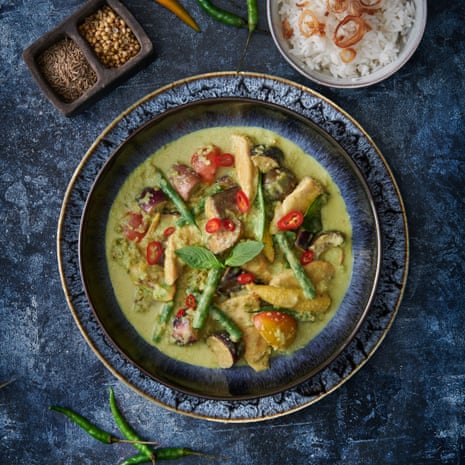The Thai name for green curry literally means green and sweet curry. Although green curry is one of the most famous Thai dishes, little is known about its historical origins. One of its first mentions was in the early 1900s by Khun Ying Plien Plassakornwong, a sort of Thai Mrs Beeton. She was a lady-in-waiting at the royal palace in Bangkok and compiled the first comprehensive cookbook of Thai recipes. The green colour is derived from green chillies, introduced to Thailand by early Portuguese traders.
My own culinary interests focus on food from the south of Thailand, where traditionally, you will find green curry made with goat and served with roti. At Supawan, we did not have green curry on our menu until my mum came to visit a few years ago. She reminded me of the right proportion of spices and fresh ingredients – also adding turmeric into the paste to give the curry a vibrant green colour. I hope my Thai green curry recipe will bring you warmth and help lift your spirits in the coming months.
Serves 4
For the curry paste (makes about 1kg, freeze any not used for this recipe)
large green chillies 700g
coriander seeds 4g, ground and toasted
cumin seeds 6g, ground and toasted
black peppercorns 6g, ground and toasted
fresh galangal root 30g, chopped
lemongrass 50g, chopped
makrut lime zest 15g
garlic 70g, chopped
shallots 130g, chopped
fresh turmeric, 70g chopped
small hot green chillies 20g
shrimp paste 20g (optional)
For the curry
makrut lime leaves 3
vegetable oil 60g
curry paste 200g (see before)
coconut milk 500g
salt 2g
palm sugar 50g
chicken stock 250g
chicken fillets 500g, sliced across into thin strips
purple aubergines 1½, cut into quarters
pea aubergines 100g, washed with stems removed (or use baby corn or bamboo shoots)
green beans 100g, cut in half
Thai aubergines 4, cut into quarters
fish sauce 45g
Thai holy basil 5 sprigs
red bird’s eye chillies 5, for garnish
I advise you to not wear any white clothes while making this recipe, and start by turning the kitchen fan on high. Make sure you’ve prepared all ingredients before starting to make the curry, as it moves quickly.
First, make the paste. Normally, in Thailand, the ingredients are pounded by hand using a stone pestle and mortar, but I recommend taking advantage of modern convenience and saving yourself some time by using a hand-held electric blender. Blitz all the ingredients until well blended.
For the curry, fry the makrut leaves in hot oil for a minute. Keep stirring and don’t let them burn.
Add the curry paste, stirring at a brisk pace until it starts to split into oil and smells fragrant, about 1-2 minutes. Pour in half of the coconut milk and keep stirring to prevent it from sticking to the bottom of the pan and burning.
Reduce the sauce by a third until a lovely oil starts to form on the top. Turn up the heat to high, season with salt, palm sugar, the rest of the coconut milk and the chicken stock, and bring to a boil.
Add the chicken and cook for about 5 minutes. Add the purple aubergine pieces and cook for 1-2 minutes, then add the rest of the vegetables. Cook for about 2 more minutes, until the vegetables are cooked, but retain their crunch. Add the fish sauce, taste, then garnish with Thai sweet basil leaves and red chillies.
Wichet Khongphoon is the chef-owner of Supawan, London N1
The Observer aims to publish recipes for sustainable fish. For ratings in your region, check: UK; Australia; US
